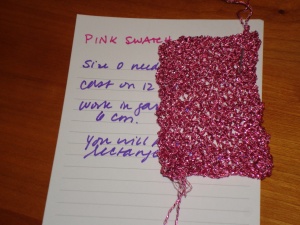It is well understood in the design community that “to fail quickly” is a good thing. You need to know when it is time to stop designing and get feedback. The sooner the better, before you are too far invested in the design, in person hours, cost of materials, and mental energy. You also need to know when it is time to throw out a design idea because it is not working.
I bet you know where I am headed in today’s blog post. Yup, I am going to check my ego at the door and write about some of my “dogs”…knitting designs that really didn’t work. And I will proudly share what I learned from each one.
Time to turn over a new leaf: Or throw it away? Recently, I experimented with knitting wire leaves for a necklace. I made three leaves and threaded them on a wire choker. The look was a bit boring, so I added pearls to the tips of each leaf.
When I showed it to my 16-year old, she said it looked like a jester’s collar. While it hurt to hear that, she was right. To address her feedback, I took off the beads from the leaf tips and threaded them on to the “seam” between each leaf. Unfortunately, now the necklace looked just random. I could only imagine what Tim Gunn might say…and it wasn’t going to be “make it work.” I had been planning to proudly wear this necklace, to publish the pattern, and to hopefully see others make them. But, it was time to hit the reset button, put the prototype aside, and make a promise to sketch my designs first before starting to knit. If I had only sketched my leaf concept, I could have spotted the problems before spending time and materials to knit it.
Not-so-pretty in pink: As I was thinking about what eventually would become the Golden Waves Necklace, I knew I wanted to create a three dimensional pendant. I had some pink metallic yarn in my stash, which I thought would be perfect. I started knitting, keeping careful notes about how many stitches I cast on, what size needles I used, and the dimensions of the knitted rectangle I created.
After casting off, I tried to mold the rectangle into a 3D shape, but it was too floppy. The metallic yarn clearly did not have the qualities of wire, which would have retained the shape I twisted it into. How disappointing! As I tugged at it, I wondered if I could use spray starch or a spray-on glue to keep it twisted. No! If I had let myself go down that path, I would have had a rigid piece of knitting most likely marred with dried drops of glue or starch. Instead, I stopped working on it, went online, and ordered some 38 gauge wire. After all, if I wanted the qualities of knitted wire, I needed to use wire. And, once it arrived, I used it to successfully create the necklace I had imagined.
While there are many more mistakes that I could share with you, I’ll leave it at just those two examples. I hope you will join me in taking the pledge to fail quickly. Celebrate constructive feedback and those times when you need to hit the reset button on a prototype. Draw energy from the experiences. Take a deep breath and then carry on!



Hey, could those leaves, with a little bit of lining, turn into the cones that you need for that pretty multi-colored necklace?
________________________________
What a brilliant idea. Thank you! I’ll give it a try and write about it in a future blog post (along with the pattern for the multi-colored necklace).